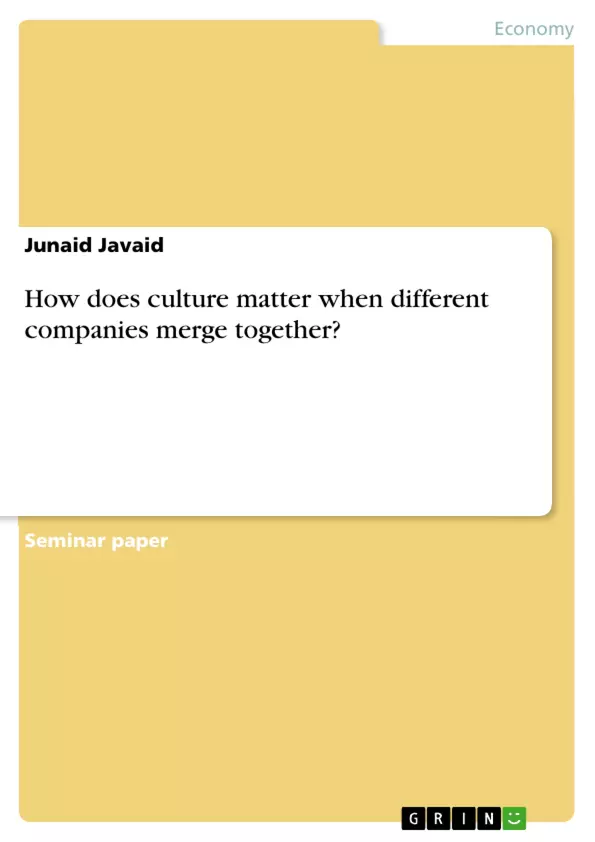This report is written on the topic of ‘How does Cultural Differences matter when the companies from different cultures merge together? The scope of this report is broad as it incorporates the implications of cultural differences in relation to the cross-border strategic alliance. Corporate Culture is used as term to signify how the managers and the workers of particular organisation tend to behave. Many international companies (Nestlè and Shell) have long term commitment towards cultural awareness and normally accepted it as an integral part of their international practices. Cultural clash and its bottom line influence are usually complicated and hard to predict. Frequently, failure to anticipate cultural clash originated from the senior managers and dealmakers lack of awareness. Understanding the prediction and mitigation of negative influence of cultural differences should be a part of cross-border alliances agenda for all management levels. From the case study chapter it has been figured out that most of American cultural traits have seemed to have direct clash with the Swedes culture which is characterised by certain aspects: modesty, values of relationship, caring and the quality of life. Both countries determined to have low power distance and high individualism but in US managemnt seemed to have slightly steeper management hierarchy than the Swedes management. Swedes ranked highlu in term of institutional collectivism but fairly low on small group or family collectivism. The vice versa case in Italian culture. Contrary to Americans, Italians are not much oriented towards performance or achievement and are turned up to be more emotional than American and Swedes and also have comparatively less future orientation. It has been recommended that Cultural differences is an impotant post-merger barrier for managers who are looking realise the value addition or the synergies impacr through the pooling of resource and capabilites of two firms from different cultures. Cultural clash and its bottom line influence are very often complicated and hard to predict. Frequently, failure to anticipate cultural clash originated from the senior managers and dealmakers lack of awareness. It has been seemed that the financial analyses which focuses only on the die-diligence process (Identifying cost-cutting benefits and counting up assets) tend to neglect any estimation on organisational and cultural synergy.
Inhaltsverzeichnis (Table of Contents)
- CHAPTER 1- AIMS & OBJECTIVES
- 1.1. BACKGROUND CONTEXT
- 1.2. RESEARCH PROBLEM
- 1.3. RESEARCH OBJECTIVES
- CHAPTER 2-LITERATURE REVIEW
- 2.1. WHAT IS CULTURE?
- 2.2. IMPORTANCE OF CULTURE
- 2.3. CULTURAL DIMENSIONS
- 2.3.1. POWER DISTANCE INDEX (PDI)
- 2.3.2. UNCERTAINTY AVOIDANCE
- 2.3.3. INDIVIDUALISM
- 2.3.4. MASCULINITY
- 2.4. APPLYING NATIONAL CULTURAL FRAMEWORK
- 2.5. CROSS CULTURAL MANAGEMENT
- 2.5.1. ORGANISATION
- 2.5.2. LEADERSHIP
- 2.5.3. COMMUNICATION
- 2.6. THE CORPORATE RESPONSE
- 2.7. CULTURAL CLASH IN INTERNATIONAL JOINT VENTURES OR CROSS BORDER M&A
- CHAPTER 3- CASE STUDY
- 3.1. CASE STUDY ON PHARMACIA AND UPJOHN
Zielsetzung und Themenschwerpunkte (Objectives and Key Themes)
This report examines the impact of cultural differences when companies from different cultures merge. It explores how cultural factors influence cross-border strategic alliances and the challenges associated with integrating diverse corporate cultures.- The Importance of Cultural Awareness in Business
- Cultural Dimensions and their Impact on Mergers and Acquisitions
- Cross-Cultural Management Strategies for Effective Integration
- The Influence of Cultural Differences on Organizational Structure and Leadership
- Case Study Analysis of Pharmacia and Upjohn Merger
Zusammenfassung der Kapitel (Chapter Summaries)
Chapter 1: Aims & Objectives
This chapter introduces the research problem, which focuses on the impact of cultural differences on mergers and acquisitions. It also outlines the research objectives, aiming to explore how cultural differences affect cross-border strategic alliances.Chapter 2: Literature Review
This chapter delves into the concept of culture and its importance in business. It explores various cultural dimensions, including power distance, uncertainty avoidance, individualism, and masculinity. The chapter also examines the application of national cultural frameworks and the challenges of cross-cultural management in areas such as organization, leadership, and communication.Chapter 3: Case Study
This chapter presents a case study of the merger between Pharmacia and Upjohn, two companies from different cultures. It examines the cultural challenges faced during the merger process and the strategies implemented to address them.Schlüsselwörter (Keywords)
The main keywords and focus topics of this report include cultural differences, mergers and acquisitions, cross-border strategic alliances, cross-cultural management, cultural dimensions, power distance, uncertainty avoidance, individualism, masculinity, organizational structure, leadership, communication, case study, and Pharmacia and Upjohn.- Quote paper
- Junaid Javaid (Author), 2013, How does culture matter when different companies merge together?, Munich, GRIN Verlag, https://www.grin.com/document/280880



